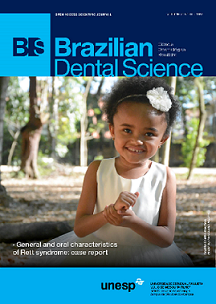Dry needling the masseter muscle in the treatment of myofascial pain: case reports
DOI:
https://doi.org/10.14295/bds.2017.v20i3.1309Abstract
The aim of this study was to evaluate treatment with dry needling (AS) in the masseter muscle of patients diagnosed with myofascial pain as the pain symptoms and the mouth opening (AB). After sample size calculation, we selected 10 patients referred for treatment of temporomandibular disorders (TMD) diagnosed with MP, with or without limited mouth opening according to Axis I of the RDC/TMD, who underwent six DN sessions, once a week. Pain measurement using the Visual Analogue Scale (VAS) and an evaluation of the extent of mouth opening were done. All participants were female and the average age was 39.2 years, with 8 (80%) having a diagnosis of myofascial pain with limited mouth opening and 2 (20%) with only myofascial pain. Maximum unaided opening without pain before treatment was 31.9 mm and went to 36.2 mm, and the maximum unaided opening went from 39.6 mm to 43.1 mm. In both, however, could not find statistical significance (p> 0.05). Regarding the mean weekly VAS value, this went from 8.3 before treatment to 2.3 a week later, with statistically significant results (p < 0.05). In this study, the AS in the masseter muscle presented is a therapeutic alternative in the treatment of myofascial pain.
Keywords
Temporomandibular joint; Temporomandibular Joint Disorders; Dry needling; Trigger points; Myofascial pain.
Downloads
Downloads
Published
How to Cite
Issue
Section
License
Brazilian Dental Science uses the Creative Commons (CC-BY 4.0) license, thus preserving the integrity of articles in an open access environment. The journal allows the author to retain publishing rights without restrictions.
=================




























